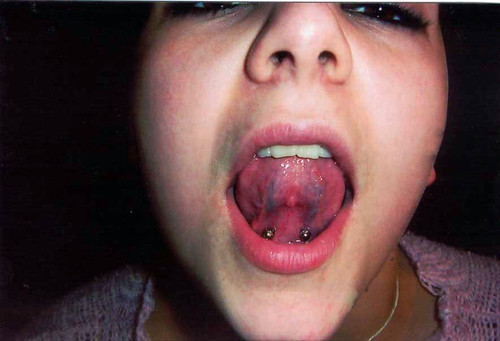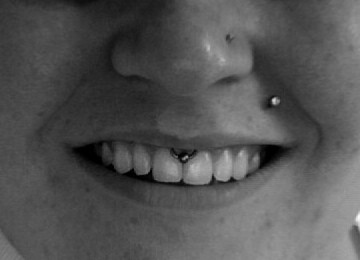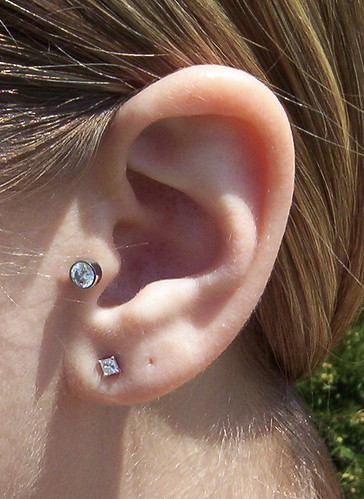Three weeks ago I head in to get two surface piercings on my chest. The counter woman asks what I have in mind, which I tell her. She explains how she's absolutely loves the look of what I wanted, but also says to discuss it with the piercer as with things of that nature, the piercer is best to sit you with something. I wait about 45 minutes and now it's my turn to figure out what's going down, what jewelery will be used, ect. Georg asks what I want, and I explain it as I did for the woman earlier. He then mentions microdermals(I asked about surface bars), and apparently he became very intrigued with what I wanted, and offers to do five microdermals, instead of three points. Then he asks, "How much do you plan on spending?". I mention about $150 or so. He says for the five dermals, it would be $175 just for the jewlery(not even including the sitting fee or being pierced). We settle on $165 that I would in total pay as he says he was becoming intrigued with what I had in mind. I'm asked what colors, ect I want. I settle on two opals, and three blacks in the shape of a v on my chest.
The procedure itself was less painful than expected. He sat me down, cleaned the area, marked me once, then looked at it for a bit to make sure it sat right. He pondered it for a bit, then asked me to look at it to make sure it's what I had in mind. I said yes, he looked at it a bit more, and then took me out to have the counter woman's point of view on the accuracy of the marks and to make sure that it was level, sat with my chest correctly, ect. She asked what the other people in the shop thought(by this time, I had five eyes looking at my chest Haha!). It was suggested to move one side up just a bit, but then it would be good.
I was taken back into the room, and layed down. I asked him many questions about the jewelry, how it was going in, why it was shaped how it was, how it worked, ect as he was preparing his table of goodies and sterile equipment. The method used was simply a dermal punch and the foot of the microdermal jewelery pushing with clamps to make a pocket under the skin. I was surprised at how less painful it was than expected. It's more pressure than anything. He kept asking if I was feeling okay, which I was. shortly after he finished one(with jewlery in)and was getting ready for the next punch, it suddenly bled down my neck. I love bleeding I had found out at that moment. Haha. He finished the rest, with my sternum being the most painful.
Also, the aftercare was relatively easy. They were a bit bloody for three days, though. I used sea salt soaks once a day, and then H2Ocean about three times with you're average, daily shower. It really comes in handy when you're at work. I used 'spot' bandaids for three days, day/night. I continued using them only every night at bedtime thereafter until I hit two weeks to keep them in place and to avoid knocking them. All was well, until one night about five days ago I woke up(still with bandaids on) and realized one of my Microdermals became a bit angry at me and tender. Sleeping on it wrong was what I felt was the problem as it was clean, only one, and was covered through the night. I've been doing one warm sea salt soak a day, using H20 about three times a day as I was before the problem, and stopped using bandaids and it seems to be dying down thankfully.
My skin hates that bandaide adhesive. That seems to be getting better as well. Make sure you take off your bandaids after a warm shoewr because it's easier on your skin, and that's the absolute best time to soak them.
I'm heading in to my piercer's shop tommorrow to have my bridge downsized a bit, and have a look at my microdermals. Georg from HPP wanted me to come in at three weeks to get a photo as he was pleased with his work, but unfortunately they are not photo worthy yet. Lame! Haha.
It was worth everything to get these little things. I've had several girls ask about them, and admire them. And that common question, "How do those stay in?!" or I get that cringe face. Haha. That's awesome.
I love them. Make sure to ask every question you have about them. Remember, these are more permanent than typical piercings. Be 100% sure, go to a reputable artist, and use common sense. You'll most likely love them. I know I do.
E-mail me with questions, comments, or whatever. Check out Georg Birns or Jim at High Priestess Piercing if you're ever in Eugene, Oregon! They have both done work on me, and thus far, I've never had any serious problems and it's made sure I get exactly what I intend on and are friendly.




















 Woman in Thailand
Woman in Thailand Woman in Italia
Woman in Italia Woman in Ethiopia
Woman in Ethiopia Woman in India
Woman in India Rikbaktsa man, ethnic groups in Brazil
Rikbaktsa man, ethnic groups in Brazil